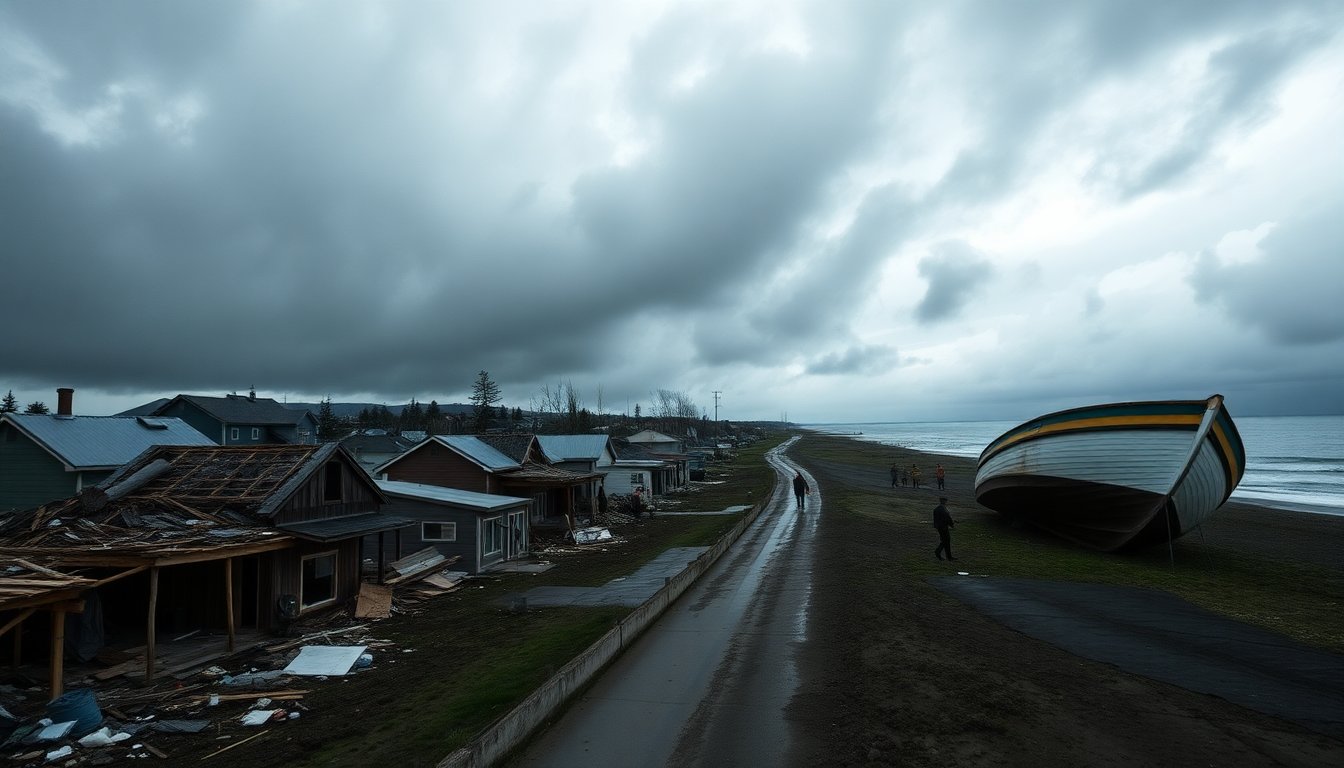Table of Contents
In a tragic turn of events for the coastal villages of Alaska, the aftermath of Typhoon Halong has unleashed a torrent of destruction, leaving more than 1,500 residents without homes. With forecasts predicting additional rain and wind, local officials are racing against time to provide shelter to those displaced. The storm, which struck during the weekend, brought intense winds and significant storm surges, hitting particularly hard in the low-lying regions of the Yukon-Kuskokwim Delta in southwestern Alaska, far removed from Anchorage.
The impact of the storm has been severe, with at least one confirmed fatality and two individuals reported missing. The Coast Guard played a crucial role in rescue efforts, evacuating dozens of people whose homes had been dislodged and were floating out to sea. As emergency shelters are established, many residents find themselves in dire conditions, with some schools acting as makeshift refuges that lack basic facilities such as functional toilets.
The extent of the devastation
The storm’s aftermath has left a profound mark on the communities of Kipnuk and Kwigillingok, which are among the hardest hit. These villages, with populations of 715 and 380 respectively, are not easily accessible during this season, relying on water or air transport. The incident commander of the state emergency management division, Mark Roberts, did not sugarcoat the situation, declaring, “It’s catastrophic in Kipnuk. Let’s not paint any other picture.” His words echoed the gravity of the circumstances as officials scrambled to provide necessary assistance.
Personal accounts of loss
Among those affected is Brea Paul from Kipnuk, who shared her harrowing experience as she witnessed numerous homes swept away under the moonlit sky. In a poignant message, she described how some houses appeared to beckon for help as they floated past her, their phone lights flickering in the night. “Some houses would blink their phone lights at us like they were asking for help but we couldn’t even do anything,” she conveyed, highlighting the helplessness felt among the residents.
After the storm, a community gathering took place in the local school gym where residents united in song, seeking solace as they contemplated their uncertain future. “It’s so heartbreaking saying goodbye to our community members not knowing when we’d get to see each other,” Paul lamented, reflecting on the emotional toll of the disaster.
Emergency response and ongoing challenges
The situation in Kwigillingok worsened when authorities found a deceased individual and had to suspend the search for two men whose home had disappeared. The school, the only facility in the area with reliable power, was overwhelmed as it hosted around 400 individuals. However, it lacked essential amenities, resulting in the use of portable toilets, commonly referred to as honey buckets.
A preliminary assessment revealed that all homes in Kwigillingok suffered damage, with approximately thirty homes reported as having drifted from their foundations. In nearby Napakiak, power systems were compromised due to flooding, while Toksook Bay experienced significant erosion. Reports from Nightmute indicated floating fuel drums and an unsettling fuel odor in the air, underscoring the environmental implications of the storm.
Long-term recovery efforts
In response to the escalating crisis, the National Guard has been deployed to assist with recovery efforts. Crews are working diligently to deliver essential supplies, including food, water, generators, and communication equipment, whenever weather conditions permit. However, officials warn that the road to recovery will be long and arduous, requiring sustained support for the communities most affected.
As winter approaches, the urgency for rebuilding becomes critical, with most materials needing to be transported into the impacted areas. Climate expert Rick Thoman from the University of Alaska Fairbanks remarked on the resilience of Alaska’s indigenous communities. Yet, he emphasized the enormity of the devastation: “When you have an entire community where effectively every house is damaged and many of them will be uninhabitable with winter knocking at the door now, there’s only so much that any individual or any small community can do.”
Thoman pointed out that the current storm’s intensity was likely exacerbated by the warming of the Pacific Ocean, a direct consequence of human-induced climate change. This is not the first time Alaska has felt the wrath of severe storms; a similar incident occurred three years ago with the remnants of Typhoon Merbok, which also left its mark on western Alaska.


